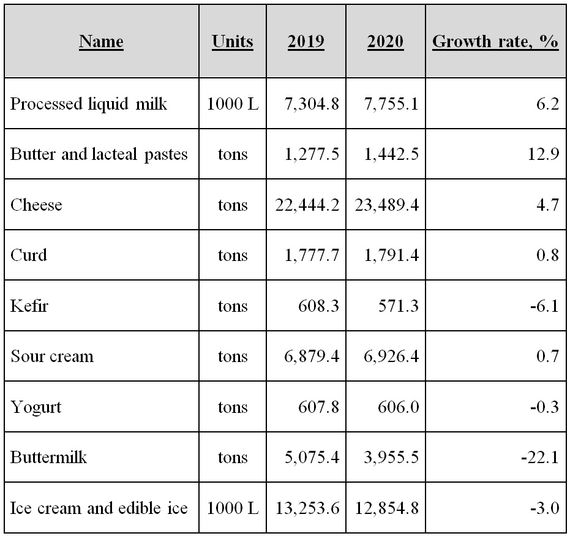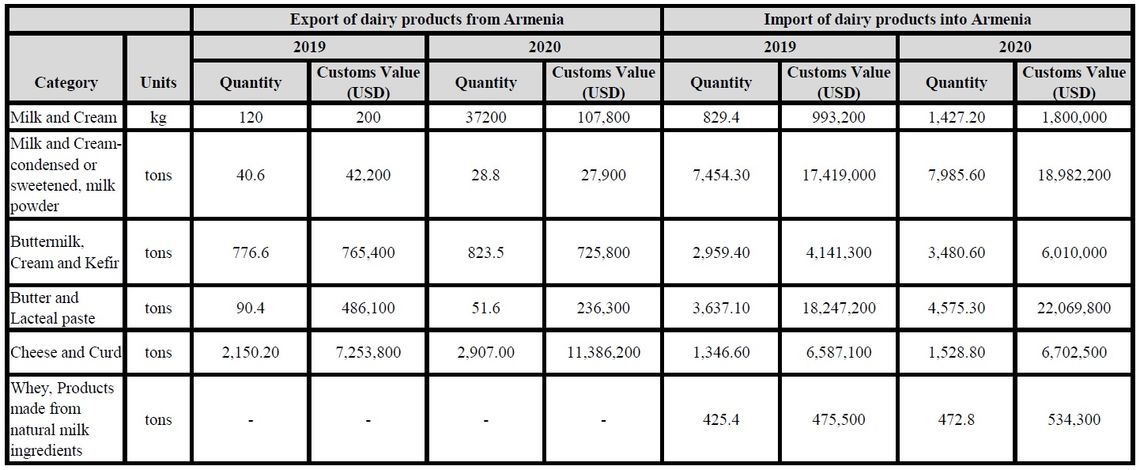
In recent years, there have been some positive developments in the Armenian dairy industry, in particular the growth in milk and dairy production, greater diversification of products, improvements in packaging and increased demand. Nevertheless, there are some outstanding issues in the industry related to management, technical capacity and hygiene standard compliance. It should also be noted that the development of the dairy industry is hampered by overgrazing of pastures in rural communities, as well as differences in the yield of natural and sowed pastures, the poor state of stock breeding and so on.
The latest data shows some worrying trends. According to official sources, the headcount of cows in the Republic of Armenia in 2020 was 251,716, a 1% decrease from 2019 (253,990) and down 4.8% from 2018 (266,815). The Gegharkunik region leads with a headcount of 45,268 cows, followed by Shirak (40,986), Lori (34,755) and Aragatsotn (31,270).
Below are Armenia’s year-on-year production statistics broken down by product type:
Table 1. Armenian dairy production statistics, 2019 vs. 2020

While production of milk and cheese increased in 2020, other segments of the market, including ice cream and yogurt, saw a decline.
It should be noted that the dairy products presented in the table are mainly exported to Russia, except for cheese, which, in relatively small quantities, is also exported to the United States, Georgia, Vietnam and Israel. Coincidently, in comparison to 2017, cheese exports in 2020 decreased almost three times (8,204,500 tons in 2017).
Table 2. Armenian dairy exports and imports

As for the geography of imports, it differs according to the types of dairy products. In particular, milk and cream are mainly imported from France, Belarus, Italy, Iran, Ukraine and Russia.
Condensed or sweetened milk powder is imported from Belarus, Ukraine, Russia, Belgium, Germany and the Netherlands. Buttermilk, kefir and cream are imported from Russia, Germany, Ukraine, Belarus and France. Whey is imported from Belarus, Russia and Ukraine. Butter and lacteal pastes are imported from New Zealand, Ukraine, Finland, France, Belarus, Ireland, Denmark, Russia, Belgium and Germany. Cheese and curd are imported from Russia, Germany, New Zealand, Italy, Finland, the Netherlands, France, Belarus and Poland.
The main problem that needs to be emphasized is that the amount of milk produced domestically in Armenia is not enough to meet the demand for all the different types of dairy products, especially during the winter months. Consequently, milk powder is imported to Armenia, as well as ready-made dairy products, in particular, butter, cheese, curd, etc. However, the demand for dairy products in Armenia is largely met by local products, with the exception of butter.
Since dairy products are essential goods, the prices of certain types of dairy products are important to keep track of. According to the Statistical Committee of Armenia, like all other consumer goods in Armenia, the prices of dairy products have also increased. In March 2021, the wider category of dairy products, cheese and eggs registered a 16.5% price increase. In particular, the price of whole milk increased by 1.6%, canned milk by 5.2%, yogurt by 3.7%, cheese and curd by 1.5%, butter by 6.9% and other dairy products by 4.5%. As for statistics on dairy consumption, the annual consumption of cheese in 2019 was 9.5 kg per capita (9.7 kg in 2018), 18.2 liters (19.0 L in 2018) for milk and yoghurt, and 1.4 kg (1.2 kg in 2018) for butter.
The decrease in per capita consumption of dairy products is due, on the one hand, to structural shifts in the average diet and, on the other hand, to the increase in dairy prices.
One of the main problems in the dairy market is the lack of differentiation in the sale of whole milk products containing vegetable oil. In particular, these products are sold in stores on the same shelves and with significant violations in labeling requirements. As a result, there is a misconception among consumers that they are buying dairy products made from whole milk at relatively affordable prices, including cheese and ice cream.
In April 2020, the State Commission for the Protection of Economic Competition of Armenia presented a package of legislative amendments, which envisages clarification of requirements for labeling dairy products. The proposed package of amendments cannot fully serve its purpose as long as labeling requirements allow dairy products containing vegetable oil to be sold along with whole milk products.
To summarize, a year ago, the Ministry of Economy submitted a package of legislative initiatives for public discussion regarding measures for selling dairy products containing vegetable oil on specifically marked shelves in all supermarkets, as well as measures for non-compliance with this requirement. So far, this package of legislative changes has not been approved by the Armenian Government, leaving the issue unresolved.
New on EVN Report

From the Forgotten Pages of History: Zabelle Boyajian, an Ambassador of Armenian Culture
By Arpine Haroyan
Born in Diyarbekir but destined to work, create and mingle among the artistic and intellectual circles of London and Europe, Zabelle Boyajian, an artist, writer, translator and British-Armenian intellectual remains a mystery to many.

Armenia’s June 2021 Parliamentary Election: The Essential Primer
By Lusine Sargsyan , Harout Manougian
Twenty-six political parties and alliances of parties have registered with the Central Electoral Commission to take part in the upcoming snap parliamentary election in Armenia. Everything you need to know about them is in this essential primer.

The Unbearable Lightness of Democratizing: Armenia’s Political Culture from Velvet Euphoria to Post-War Melancholy
By Nerses Kopalyan
Tracing political cultural trends that have been formulating in Armenia through three short, yet fastly-developing, stages: prior to the Velvet Revolution, subsequent to the Velvet Revolution, and after the 2020 Artsakh War.

Seeking Permanence in Pixels: Digital Echoes of Cultural Genocide
By Roza Melkumyan
For decades, the Azerbaijani government has engaged in the destruction of Armenian monuments in its quest to erase all evidence of our culture. But the campaign of cultural erasure stretches beyond the physical, to the digital realm as well.




